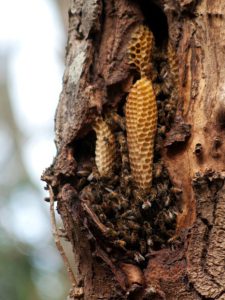Varroa mite response shifts to Eradication of wild European honey bee management in Australia

Efforts to keep NSW Varroa mite free continue to move into the next phase in the Hunter region, with the program to euthanise wild European honey bees in the eradication emergency (red) zone, following a successful first round of the baiting in the area of Jerrys Plains.
NSW Department of Primary Industries (NSW DPI) Chief Plant Protection Officer Dr Satendra Kumar said as NSW DPI continues efforts to remove wild European honey bees are from the eradication emergency (red) zone, the program is now set to begin in Denman.
“Wild European honey bees, which are the same species as honeybees kept in managed hives, build their nests in tree hollows and other enclosed spaces,” said Dr Kumar.
“Removing these bees from the environment of eradication emergency (red) zones is necessary to reduce any chance of the Varroa mite parasite existing undetected within wild hives, and is an important part of the national Varroa mite response plan.”
Dr Kumar said the baiting program has been developed to include strict guidelines to protect and ensure the safety of all people, animals, livestock and the local environment.
“NSW DPI has been authorised by the Australian Pesticides and Veterinary Medicines Authority to use fipronil to remove wild European honey bees.
“The bait stations are designed to exclude other animals and insects, and to prevent contamination of soil and water.
“Bait stations will remain in place for up to 12 months, but only in active use with insecticide for very short periods of time, to a maximum of 3 hours each session.
“During active use, bait stations will be monitored by trained staff, to minimise the risk of off-target impacts. Experience to date has shown zero feeding in stations by off target species.
“Bait stations are placed at least 2 kms away from the edges of the red eradication emergency zones to reduce the risk of European honey bees from outside the eradication zone interacting with the bait stations.”
Beekeepers in eradication emergency (red) zones whose hives have been euthanised continue to be eligible for compensation.
Commercial registered beekeepers in the purple surveillance emergency zone are also now eligible for reimbursement.
“In line with the program guidelines set by the NSW Rural Assistance Authority, only registered beekeepers will be eligible for reimbursement, so I strongly encourage any beekeepers in those zones to make sure they’re a registered beekeeper in NSW,” Dr Kumar said.
Planning and preparation of the baiting program has been conducted by NSW DPI in consultation with the Environment Protection Authority, Local Land Services (LLS) and NSW National Parks and Wildlife Service.
NSW DPI has also worked closely with industry representatives of the Australian Honey Bee Industry Council, NSW Apiarists’ Association, Amateur Beekeepers Australia and the Australian Native Bee Association.
We are here to share current happenings in the bee industry. Bee Culture gathers and shares articles published by outside sources. For more information about this specific article, please visit the original publish source: Varroa mite response shifts to wild European honey bee management in Denman | Mirage News






